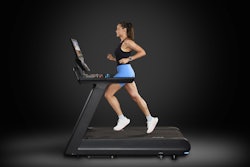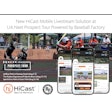Source: The National Athletic Trainers' Association
Washington, DC, March 10, 2014 – The National Athletic Trainers’ Association advance released today a new position statement on the management of sport concussion during the 5th annual Youth Sports Safety Summit in Washington, DC. This statement is an update to the association’s original 2004 concussion guidelines and addresses education, prevention, documentation and legal aspects, evaluation and return-to-play considerations. In particular, the authors amended the return-to-play guidelines and now recommend no return on the day the athlete is concussed.
The statement, created by the NATA Research & Education Foundation, will appear in the March issue of the Journal of Athletic Training, NATA’s scientific publication. To review the statement please visit: https://dx.doi.org/10.4085/1062-6050-49.1.07.
Concussion key statistics:
•An estimated 3.8 million concussions occur each year as a result of sport and physical activity.
•Sport-related concussions account for 58 percent of all emergency department visits in children (8-13 years old) and 46 percent of all concussions in adolescents (14-19 years old).
•Athletes who have had one concussion are 1.5 times more likely to have a second; those who have sustained two concussions have a nearly three times greater risk and those with three or more have a 3.5 times higher risk.
•Data from the High School Reporting Information Online (RIO) indicated that concussions in interscholastic athletes were responsible for 8.9 percent of all athletic injuries.
“With the continued national spotlight on concussions from professional to youth sports, these recommendations provide a practical roadmap for athletic trainers, physicians and other medical professionals on injury identification and management. We also hope this document will serve as an educational tool for parents and school administrators,” said Steven P. Broglio, PhD, ATC, lead author of the position statement and director of the Neurosport Research Lab in the School of Kinesiology at the University of Michigan.
“Athletic trainers (ATs) are commonly the first medical experts available on site to identify and evaluate injuries,” added Broglio. “Without exception, ATs should be present at all organized sporting events – from practices to games – and at all levels of play and work closely with their physician or other designated medical expert to implement these guidelines. In light of these general protocols, each athlete should be treated on an individual basis.”
Highlights of NATA position statement on concussion management:
Education and Prevention
•Use proper terminology such as concussion or traumatic brain injury as opposed to colloquial terms as “ding” or “bell ringer,” which minimize the injury severity.
•Educate administrators, sports medicine team members, coaches, parents and others on concussion prevention, cause, recognition and referral, physical and cognitive restrictions for concussed athletes, return-to-play protocols and ramifications of improper concussion management.
•Document potential modifying factors that could delay return to participation, and educate patients on these implications.
•Understand limitations of protective equipment for concussion prevention, and read all warning labels associated with that equipment.
Documentation and legal aspects
•Be aware of state legislation as well as sport governing bodies and their policies and procedures regarding concussion management.
•Document the athlete’s (and when appropriate the parent’s) understanding of concussive signs and symptoms and his/her responsibility to report a concussion.
•Communicate the status of concussed athletes to the managing physician; document all evaluation, management, treatment, return to participation and physician communications.
Evaluation and return-to-play
•Athletes at high risk of concussions (those in collision or contact sports) should undergo baseline examinations before the competitive season.
•Baseline examinations should be completed annually for adolescent athletes, those with recent concussions and, when feasible, all athletes.
•Baseline exam should consist of clinical history, physical and neurologic evaluations, measure of motor control and neurocognitive functions.
•Any athlete suspected of a concussion should be removed from play; not return to activity on the day of injury; and be evaluated by a physician or AT.
o Once the concussion diagnosis is made, the patient should undergo daily focused examinations to monitor the course of recovery and be cleared by a physician before returning to play.
o Those athletes with a history of concussions or who do not show a typical return to normal functioning after injury may benefit from a referral to a neuropsychologist or additional treatments or therapies.
Other considerations
Equipment:
•The AT should enforce the standard use of certified helmets and educate athletes, coaches and parents that, although helmets can help prevent catastrophic injuries, they do not significantly reduce the risk of concussions.
•Helmet use in high-velocity sports (e.g. skiing, cycling) has been shown to protect against traumatic head and facial injury.
•Consistent evidence demonstrating a reduced concussion risk by wearing a mouthguard is not available, though evidence demonstrates that fitted mouthguards reduce dental injuries.
•Research on the effectiveness of headgear in soccer players is limited; use of headgear is neither encouraged nor discouraged at this time.
Pediatric concussion:
•Be aware that recovery among young athletes may take longer than in adults and require a longer return-to-play progression.
•Use age-appropriate, validated concussion-assessment tools with younger athletes; a parent, teacher or responsible adult should also monitor and report symptoms.
•Young athletes undergo continual brain and cognitive development and may require more frequent updates to the baseline assessments.
•ATs, school administrators and teachers should work together to include appropriate academic accommodations in the concussion management plan.
Home care:
· Implement a standard concussion home instruction form for all patients.
· Instruct a concussed patient to avoid medications other than acetaminophen, and avoid alcohol, drugs or other substances.
· Recommend rest as the best practice for concussion recovery; during the acute stage of injury patients should avoid any physical or mental exertion that exacerbates symptoms, maintain a healthy diet and stay well hydrated.
· Ensure school administrators, counselors and instructors are aware of the patient’s injury.
Multiple concussions:
· In those with a concussion history, recognize the potential for second-impact syndrome and be aware of the potential long-term consequences of multiple injuries.
· Consider patient referral to a physician with specific concussion training and experience if an athlete has a history of concussions.
For more information on concussions and youth sports safety, please visit www.nata.org or www.youthsportssafetyalliance.org.
About NATA:
Athletic trainers are health care professionals who specialize in the prevention, diagnosis, treatment and rehabilitation of injuries and sport-related illnesses. They prevent and treat chronic musculoskeletal injuries from sports, physical and occupational activity, and provide immediate care for acute injuries. Athletic trainers offer a continuum of care that is unparalleled in health care. The National Athletic Trainers' Association represents and supports 39,000 members of the athletic training profession. Visit www.nata.org.































